Hammer and sickle
The hammer and sickle (Unicode: "☭")[lower-alpha 1] is a symbol meant to represent proletarian solidarity – a union between the peasantry and working-class. It was first adapted during the Russian Revolution, the hammer representing the workers and the sickle representing the peasants.[1]
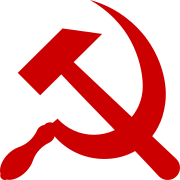
After World War I (which Russia quit in 1917) and the Russian Civil War, the hammer and sickle became more widely used as a symbol for labor within the Soviet Union and for international proletarian unity. It was taken up by many communist movements around the world, some with local variations. Today, even after the dissolution of the Soviet Union, the hammer and sickle remains commonplace in Russia and other former union republics, but its display is prohibited in some other former communist countries as well as in countries where communism is banned by law. The hammer and sickle also remains commonplace in countries like Vietnam and China which are still self-described socialist states.
History
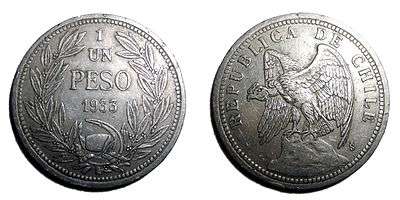
Worker symbolism
Farm and worker instruments and tools have long been used as symbols for proletarian struggle.
The combination of hammer and sickle symbolised the combination of farmers and construction workers. One example of use prior to its political instrumentalisation by the Soviet Union is found in Chilean currency circulating since 1895.[2]
An alternative example is the combination of a hammer and a plough, with the same meaning (unity of peasants and workers). In Ireland, the symbol of the plough remains in use. The Starry Plough banner was originally used by the Irish Citizen Army, a socialist republican workers' militia. James Connolly, co-founder of the Irish Citizen Army with Jack White, said the significance of the banner was that a free Ireland would control its own destiny from the plough to the stars. A sword is forged into the plough to symbolise the end of war with the establishment of a Socialist International. This was unveiled in 1914 and flown by the Irish Citizen Army during the 1916 Easter Rising.
.svg.png)
Inception
In 1917, Vladimir Lenin and Anatoly Lunacharsky held a competition to create a Soviet emblem. The winning design was a hammer and sickle on top of a globe in rays of the sun, surrounded by a wreath of grain and under a five-pointed star, with the inscription "proletariats of the world, unite!" in six languages (Russian, Ukrainian, Belarusian, Georgian, Armenian and Azerbaijani). It originally featured a sword, but Lenin strongly objected, disliking the violent connotations.[3] The winning designer was Yevgeny Ivanovich Kamzolkin (1885–1957).[4][5]
On 6 July 1923, the 2nd session of the Central Executive Committee (CIK) adopted this emblem.[3]
Usage in the Soviet Union
- The State Emblem of the Soviet Union and the Coats of Arms of the Soviet Republics showed the hammer and sickle, which also appeared on the red star badge on the uniform cap of the Red Army uniform and in many other places.
- Serp i Molot (transliteration of Russian: cерп и молот, "sickle and hammer") is the name of the Moscow Metallurgical Plant.
- Serp i Molot is also the name of a stop on the electric railway line from Kurski railway station in Moscow to Gorky, featured in Venedikt Yerofeyev's novel, Moscow-Petushki.
.svg.png)
Meaning
At the time of creation, the hammer and sickle stood for worker-peasant alliance, with the hammer a traditional symbol of the industrial proletariat (who dominated the proletariat of Russia) and the sickle a traditional symbol for the peasantry, but the meaning has since broadened to a globally recognizable symbol for Marxism, Marxist parties, or socialist states.[3]
In the Soviet Union, the hammer and sickle came to take on a gendered meaning, with the sickle coming to be associated with women and the hammer men.[3]
Contrary to the popular belief, the symbol is also widely used as a World War II resistance symbol against Nazism in which the Soviet soldiers and citizens died during the war.
Current usage
Post-Soviet states
.svg.png)

Two federal subjects of the post-Soviet Russian Federation use the hammer and sickle in their symbols: the Vladimir Oblast has them on its flag and the Bryansk Oblast has them on its flag and coat of arms, which is also the central element of its flag. In addition, the Russian city of Oryol also uses the hammer and sickle on its flag.
The former Soviet (now Russian) national airline, Aeroflot, continues to use the hammer and sickle in its symbol.
The hammer and sickle can be found as a logo on most ushanka hats, usually the Soviet-styled ones.
The de facto government of Transnistria uses (with minor modifications) the flag and the emblem of the former Moldavian SSR, which includes the hammer and sickle. The flag can also appear without the hammer and sickle in some circumstances, for example on Transnistrian-issued license plates.
Communist parties
Four out of the six currently ruling Communist parties use a hammer and sickle as the party symbol: the Communist Party of China, the Communist Party of Vietnam, the Lao People's Revolutionary Party and the Nepal Communist Party. All of these use the yellow-on-red colour scheme, except for the Nepal Communist Party which uses white-on-red. In Laos and Vietnam, the hammer and sickle party flags can often be seen flying side by side with their respective national flags.
Many communist parties around the world also use it, including the Communist Party of Greece,[6] the Communist Party of Chile, the Communist Party of Brazil, the Purba Banglar Sarbahara Party from Bangladesh, the Communist Party of Sri Lanka, the Communist Party of India (Marxist), the Communist Party of India (Marxist–Leninist) Liberation, the Communist Party of India, the Communist Party of India (Maoist), the Indian Communist Marxist Party, the Socialist Unity Centre of India (Communist), the Egyptian Communist Party, the Communist Party of Pakistan, the Communist Party of Spain, the Communist Party of Denmark, the Communist Party of Norway, the Romanian Communist Party, the Lebanese Communist Party, the Communist Party of the Philippines and the Shining Path. The Communist Party of Sweden, the Portuguese Communist Party[7] and the Mexican Communist Party use the hammer and sickle imposed on the red star. The hammer and sickle accompanied by the yellow star is used by the Communist Refoundation Party, the main communist party in Italy, the country with the most usage of the symbol around the world: hammer and sickle was used in past by the Italian Socialist Party, the Proletarian Unity Party (Italy) and its forerunner Italian Socialist Party of Proletarian Unity, the Proletarian Democracy and the Party of Italian Communists, all parties formerly represented in the Italian Parliament.
Variations
Many symbols having similar structures and messages to the original have been designed. For example, the Angolan flag shows a segment of a cog, crossed by a machete and crowned with a socialist star while the flag of Mozambique features an AK-47 crossed by a hoe. In the logo of the Communist Party USA, a circle is formed by a half cog and a semicircular sickle-blade. A hammer is laid directly over the sickle's handle with the hammer's head at the logo's center. The logo of the Communist Party of Turkey consists of half a cog wheel crossed by a hammer, with a star on the top.
Tools represented in other designs include: the brush, sickle and hammer of the Workers' Party of Korea; the spade, flaming torch and quill used prior to 1984 by the British Labour Party (which is a socialist and not a communist party); the pickaxe and rifle used in communist Albania; and the hammer and compasses of the East German emblem and flag. The Far Eastern Republic of Russia used an anchor crossed over a spade or pickaxe, symbolising the union of the fishermen and miners. The Fourth International, founded by Leon Trotsky, uses a hammer and sickle symbol on which the number 4 is superimposed. The hammer and sickle in the Fourth International symbol are the opposite of other hammer and sickle symbols in that the head of the hammer is on the right side and the sickle end tip on the left. The Trotskyist League for the Fifth International merges a hammer with the number 5, using the number's lower arch to form the sickle. A sickle with a rifle is also used by the Marxist and Islamist group People's Mojahedin of Iran.
The Communist Party of Britain (CGB) uses the hammer and dove symbol. Designed in 1988 by Michal Boncza, it is intended to highlight the party's connection to the peace movement. It is usually used in conjunction with the hammer and sickle and it appears on all of the CPB's publications. Some members of the CPB prefer one symbol over the other, although the party's 1994 congress reaffirmed the hammer and dove's position as the official emblem of the party. Similarly, the Communist Party of Israel uses a dove over the hammer and sickle as its symbol. The flag of the Guadeloupe Communist Party uses a sickle, turned to look like a majuscule G, to represent Guadeloupe.[8]
The flag of the Black Front, a Strasserist group founded by early Nazi Party members and expelled around the time of the Night of the Long Knives purge, along with his supporters and the Sturmabteilung and originator of the ideology and the Black Front himself Otto Strasser, featured a crossed hammer and sword, symbolizing the unity of the workers and military.
The flag of Burma (from 1974–2010) featured a bushel of rice superimposed on a cogwheel.
The flag of Chama Cha Mapinduzi (CCM, Party of the Revolution in Swahili), currently the ruling political party of Tanzania, has a slightly different symbol with a hammer and a hoe (jembe) instead of a sickle to represent the most common farm tool in Africa.
The National Bolshevik Party used the hammer and sickle in their flag, but colored black instead of gold and in a design similar to the Nazi flag, a brighter red flag than the USSR, with a black hammer and sickle on a white disk in the center.
Art
The hammer and sickle has long been a common theme in socialist realism, but it has also seen some depiction in non-Marxist popular culture. Andy Warhol who created many drawings and photographs of the hammer and sickle is the most famous example of this.
 The metro station, Ploshchad Lenina, Minsk
The metro station, Ploshchad Lenina, Minsk Sándor Pinczehelyi, Hammer and Sickle
Sándor Pinczehelyi, Hammer and Sickle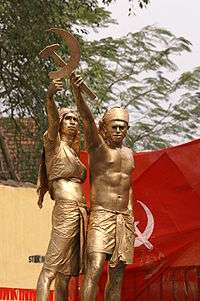
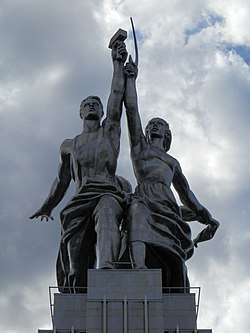
Legal status
In several countries in the former Eastern Bloc, there are laws that define the hammer and sickle as the symbol of a "totalitarian and criminal ideology" and the public display of the hammer and sickle and other Communist symbols such as the red star is considered a criminal offence. Georgia,[9] Hungary,[10] Latvia,[11] Lithuania,[12] Moldova (1 October 2012 – 4 June 2013)[13] and Ukraine[14][15][16] have banned communist symbols including this one. A similar law was considered in Estonia, but it eventually failed in a parliamentary committee.
In 2010, the Lithuanian, Latvian, Bulgarian, Hungarian, Romanian, and Czech governments called for the European Union to criminalize "the approval, denial or belittling of communist crimes" similar to how a number of EU member states have banned Holocaust denial. The European Commission turned down this request, finding after a study that the criteria for EU-wide criminal legislation was not met, leaving individual member states to determine the extent to wished they wished to handle past totalitarian crimes.[17]
In February 2013, the Constitutional Court of Hungary annulled the ban on the use of symbols of fascist and communist dictatorships, including the hammer and sickle, the red star and the swastika, saying the ban was too broad and imprecise. The court also pointed to a judgement of the European Court of Human Rights in which Hungary was found guilty of violation of article 10, the right to freedom of expression.[18] In June 2013, the Constitutional Court of Moldova ruled that the Moldovan Communist Party’s symbols—the hammer and sickle—are legal and can be used.[19]
In Indonesia, the display of communist symbols and the country's Communist party was banned by decree of United States–supported[20] dictator Suharto, following the 1965–1966 killings of communists in which over 500,000 people were killed,[20] with the United States providing financial support and targets for assassination to the Suharto dictatorship.[21] In January 2018, an activist protesting against Bumi Resources displayed the hammer and sickle, was accused of spreading communism, and later jailed.[22]
In Poland, dissemination of items which are "mediums of fascist, communist or other totalitarian symbolism" was criminalized in 1997. However, the Constitutional Tribunal found this sanction to be unconstitutional in 2011.[23]
Usage
Flags
Europe
 Flag of the Soviet Union from 19 August 1955 to 26 December 1991
Flag of the Soviet Union from 19 August 1955 to 26 December 1991 Naval Jack of the Soviet Union from 16 November 1950 to 12 July 1992
Naval Jack of the Soviet Union from 16 November 1950 to 12 July 1992.svg.png) Naval ensign of the Soviet Union from 16 November 1950 to 27 July 1992
Naval ensign of the Soviet Union from 16 November 1950 to 27 July 1992 Flag of the Communist Party of the Donetsk People's Republic
Flag of the Communist Party of the Donetsk People's Republic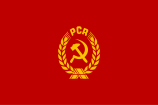 Flag of the Romanian Communist Party
Flag of the Romanian Communist Party Flag of the Communist Party of the Russian Federation
Flag of the Communist Party of the Russian Federation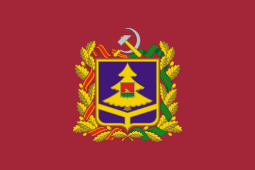 Flag of Bryansk Oblast (Russia)
Flag of Bryansk Oblast (Russia)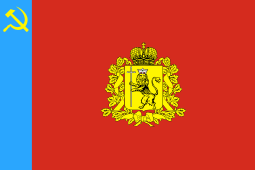 Flag of Vladimir Oblast (Russia)
Flag of Vladimir Oblast (Russia) Flag of Oryol (Russia)
Flag of Oryol (Russia) Flag of the Italian Communist Party
Flag of the Italian Communist Party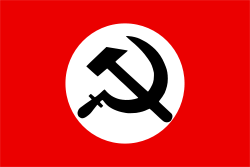 The flag of the National Bolshevik Party, and by extension, National Bolshevism
The flag of the National Bolshevik Party, and by extension, National Bolshevism Flag of the Sammarinese Communist Party
Flag of the Sammarinese Communist Party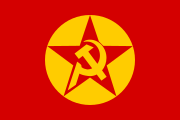 The flag of the Revolutionary People's Liberation Party–Front (Turkey)
The flag of the Revolutionary People's Liberation Party–Front (Turkey) Flag of the Portuguese Communist Party
Flag of the Portuguese Communist Party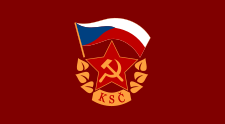

Asia
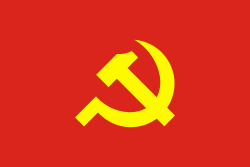 Flag of the Communist Party of Vietnam
Flag of the Communist Party of Vietnam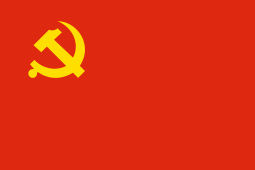 Flag of the Communist Party of China
Flag of the Communist Party of China.svg.png) Flag of the Communist Party of China (before 1996)
Flag of the Communist Party of China (before 1996)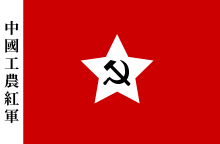 Flag of Chinese Workers' and Peasants' Red Army
Flag of Chinese Workers' and Peasants' Red Army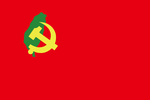 Flag of the Taiwan Democratic Communist Party
Flag of the Taiwan Democratic Communist Party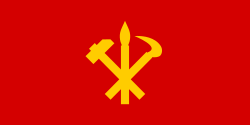 Flag of Workers' Party of Korea
Flag of Workers' Party of Korea Flag of the Communist Party of India
Flag of the Communist Party of India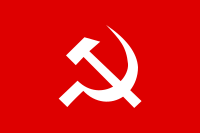 Flag of the Communist Party of India (Marxist)
Flag of the Communist Party of India (Marxist)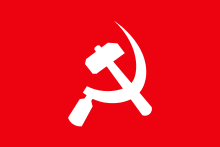 Flag of various South Asian communist parties, including the Communist Party of India (Maoist)
Flag of various South Asian communist parties, including the Communist Party of India (Maoist) Flag of the Socialist Unity Centre of India
Flag of the Socialist Unity Centre of India Flag of the Communist Party of Bangladesh
Flag of the Communist Party of Bangladesh Flag of the Nepal Communist Party
Flag of the Nepal Communist Party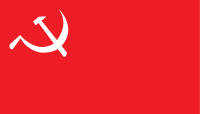 Flag of the Bhutan Communist Party
Flag of the Bhutan Communist Party Flag of PKI (Indonesia)
Flag of PKI (Indonesia) Flag of the Socialist Party of Timor
Flag of the Socialist Party of Timor.svg.png) Flag of the Communist Party of the Philippines
Flag of the Communist Party of the Philippines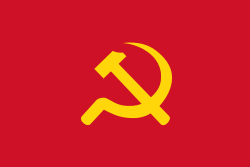 Flag of Lao People's Revolutionary Party
Flag of Lao People's Revolutionary Party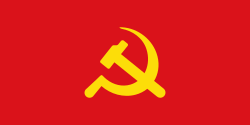 Flag of Communist Party of Cambodia
Flag of Communist Party of Cambodia Flag of the Malayan Communist Party from 30 April 1930 to 2 December 1989
Flag of the Malayan Communist Party from 30 April 1930 to 2 December 1989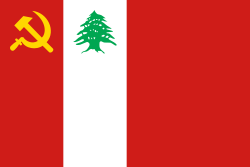 Flag of the Lebanese Communist Party
Flag of the Lebanese Communist Party Flag of the Syrian Communist Party (Bakdash)
Flag of the Syrian Communist Party (Bakdash).svg.png) Flag of the Kurdistan Workers' Party (1978–1995)
Flag of the Kurdistan Workers' Party (1978–1995)- Flag of the Jordanian Communist Party
Africa
 Flag of the Algerian Communist Party
Flag of the Algerian Communist Party
America
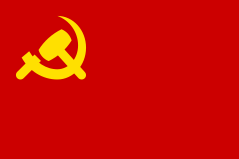 Flag of Shining Path
Flag of Shining Path
State emblems
Soviet Union (in the constitutional order)
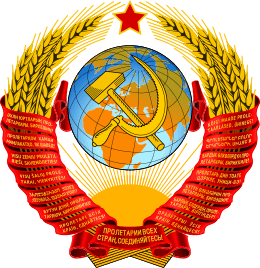
 Emblem of the Russian Soviet Federative Socialist Republic
Emblem of the Russian Soviet Federative Socialist Republic.svg.png) Emblem of the Russian Federation (1992-1993)
Emblem of the Russian Federation (1992-1993)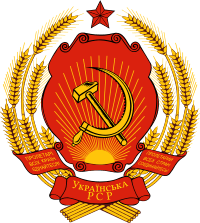
.svg.png)
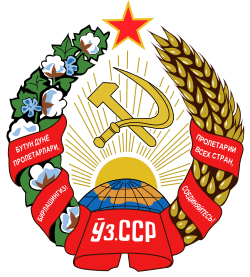
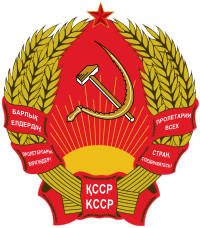
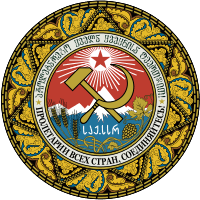
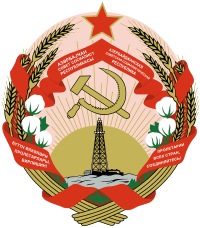
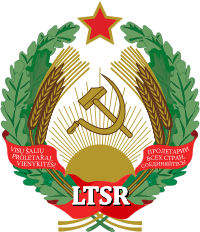
.svg.png)
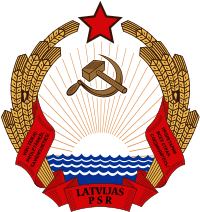
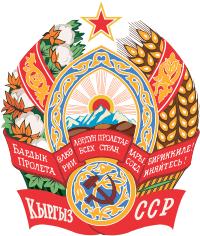
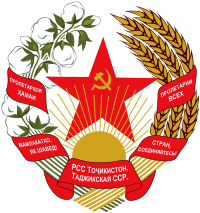
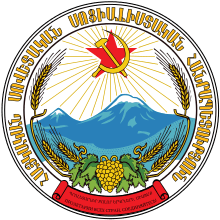
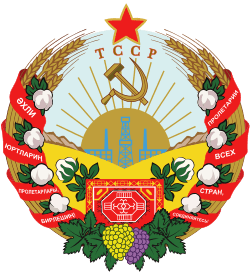
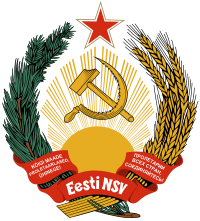
.svg.png) Emblem of the Transcaucasian Socialist Federative Soviet Republic (1923‒1936)
Emblem of the Transcaucasian Socialist Federative Soviet Republic (1923‒1936) Emblem of the Karelo-Finnish Soviet Socialist Republic (1941‒1956)
Emblem of the Karelo-Finnish Soviet Socialist Republic (1941‒1956)
Other
.svg.png) State emblem of the Tuvan People's Republic (1943‒1944)
State emblem of the Tuvan People's Republic (1943‒1944) Emblem of the self-proclaimed Pridnestrovian Moldavian Republic
Emblem of the self-proclaimed Pridnestrovian Moldavian Republic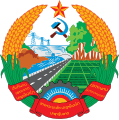 State emblem of the Lao People's Democratic Republic (1975‒1991)
State emblem of the Lao People's Democratic Republic (1975‒1991)
Logos
Europe
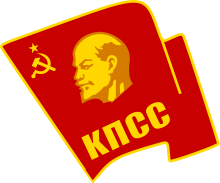 Emblem of the Bolshevik Party
Emblem of the Bolshevik Party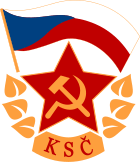 Emblem of the Communist Party of Czechoslovakia
Emblem of the Communist Party of Czechoslovakia Emblem of the Romanian Communist Party
Emblem of the Romanian Communist Party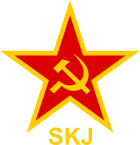 Emblem of the League of Communists of Yugoslavia
Emblem of the League of Communists of Yugoslavia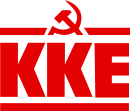 Logo of the Communist Party of Greece
Logo of the Communist Party of Greece Logo of the Italian Communist Party
Logo of the Italian Communist Party.png) Logo of the Italian Socialist Party
Logo of the Italian Socialist Party Logo of the Proletarian Unity Party (Italy)
Logo of the Proletarian Unity Party (Italy) Logo of the Italian Communist Party
Logo of the Italian Communist Party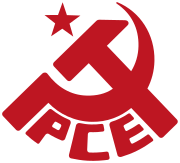 Logo of the Communist Party of Spain
Logo of the Communist Party of Spain.jpg) Emblem of the Communist Party of the Peoples of Spain
Emblem of the Communist Party of the Peoples of Spain Logo of the Portuguese Communist Party
Logo of the Portuguese Communist Party Logo of the Communist Party of Ireland
Logo of the Communist Party of Ireland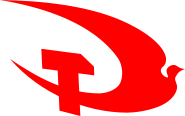 Logo of the Communist Party of Britain
Logo of the Communist Party of Britain Logo of the Young Communist League of Great Britain
Logo of the Young Communist League of Great Britain
 Logo of the Communist Party (Sweden)
Logo of the Communist Party (Sweden)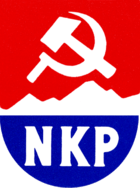 The Logo of the Communist Party of Norway
The Logo of the Communist Party of Norway Logo of the Communist Party of Denmark
Logo of the Communist Party of Denmark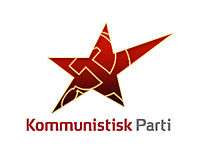 Logo of the Communist Party (Denmark)
Logo of the Communist Party (Denmark) Logo of the Finnish Communist Worker's Party
Logo of the Finnish Communist Worker's Party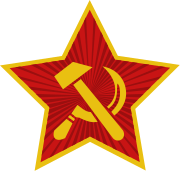 Logo of the Communist Party of Germany
Logo of the Communist Party of Germany.tif.png) Logo of the Communist Party (Switzerland)
Logo of the Communist Party (Switzerland) Logo of the New Communist Party of the Netherlands
Logo of the New Communist Party of the Netherlands Logo of the Communist Party of Belgium (1989)
Logo of the Communist Party of Belgium (1989)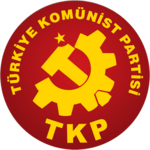 Emblem of the Communist Party of Turkey
Emblem of the Communist Party of Turkey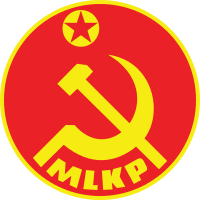 Badge of the Marxist–Leninist Communist Party of Turkey
Badge of the Marxist–Leninist Communist Party of Turkey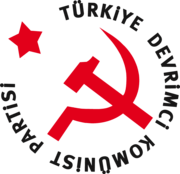 Logo of the Revolutionary Communist Party of Turkey
Logo of the Revolutionary Communist Party of Turkey Logo of Aeroflot
Logo of Aeroflot
Asia
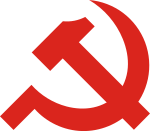 Emblem of the Communist Party of Vietnam
Emblem of the Communist Party of Vietnam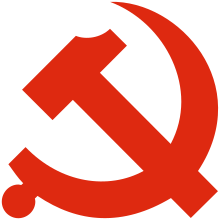 Emblem of the Communist Party of China
Emblem of the Communist Party of China Logo of the Ministry of State Security
Logo of the Ministry of State Security Emblem of Workers' Party of Korea
Emblem of Workers' Party of Korea Symbol of the Communist Party of Indonesia (1914‒1966)
Symbol of the Communist Party of Indonesia (1914‒1966) Logo of the Current Maki Party
Logo of the Current Maki Party.png) Emblem of the Afghanistan Liberation Organization
Emblem of the Afghanistan Liberation Organization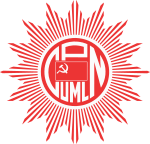
 Logo of the Socialist Party of Bangladesh
Logo of the Socialist Party of Bangladesh
Africa
.svg.png) Logo of the Workers' Party of Tunisia
Logo of the Workers' Party of Tunisia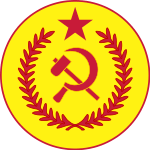 Logo of the Ethiopian People's Revolutionary Party
Logo of the Ethiopian People's Revolutionary Party Emblem of FRELIMO
Emblem of FRELIMO
America
 Logo of the Mexican Communist Party
Logo of the Mexican Communist Party Logo of the Communist Party of Chile
Logo of the Communist Party of Chile Logo of the Brazilian Communist Party
Logo of the Brazilian Communist Party Logo of the Communist Party of Brazil
Logo of the Communist Party of Brazil Emblem of the Communist Party USA
Emblem of the Communist Party USA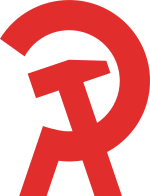 Logo of the Communist Party of Argentina
Logo of the Communist Party of Argentina Logo of the Communist Party of Uruguay
Logo of the Communist Party of Uruguay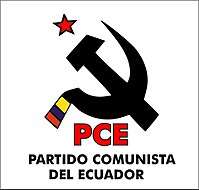 Logo of the Communist Party of Ecuador
Logo of the Communist Party of Ecuador Logo of Shining Path
Logo of Shining Path the logo of the Peruvian Communist Party
the logo of the Peruvian Communist Party
Unicode
In Unicode, the "hammer and sickle" symbol is U+262D (☭). It is part of the Miscellaneous Symbols (2600–26FF) code block. On systems where Compose key is available, it could be written as [Compose]+CCCP. It was added to Unicode 1.1 in 1993.[24]
See also
- Arm and hammer
- Communist symbolism
- Hammer and pick (⚒)
- National Emblem of East Germany ("hammer and compass")
- Red flag (⚑)
- Red star (★)
- Transport and Map Symbols Unicode block (contains 🛠 "hammer and wrench" as U+1F6E0)
Notes
References
- "Flag of Union of Soviet Socialist Republics". Encyclopedia Britannica. Retrieved 30 November 2019.
- "Chilean peso design, 1894". Retrieved 7 May 2018.
- "The Hammer and Sickle: The Role of Symbolism and Rituals in the Russian Revolution". Retrieved 3 August 2014.
- International People's Tribunal 1965, "The Spectre of Hammer and Sickle" Archived 14 September 2015 at the Wayback Machine. Retrieved 6 November 2015.
- International Gallery of Contemporary Artists Archived 16 August 2016 at the Wayback Machine. Retrieved 6 November 2015.
- "KKE - Αρχική". kke.gr.
- "Estatutos do PCP, art. 72". pcp.pt/estatutos-do-pcp.
- "Parti Communiste Guadeloupéen". flagspot.net.
- Communist symbols to be banned in Georgia, BBC News, 4 May 2014, retrieved 13 May 2014
- "Act C of 2012 on the Criminal Code, Section 335: Use of Symbols of Totalitarianism" (PDF). Ministry of Interior of Hungary. p. 97. Retrieved 21 February 2017.
Any person who: a) distributes, b) uses before the public at large, or c) publicly exhibits, the swastika, the insignia of the SS, the arrow cross, the sickle and hammer, the five-pointed red star or any symbol depicting the above so as to breach public peace – specifically in a way to offend the dignity of victims of totalitarian regimes and their right to sanctity – is guilty of a misdemeanor punishable by custodial arrest, insofar as they did not result in a more serious criminal offense.
- Latvia Bans Soviet, Nazi Symbols, RIA Novosti, 21 June 2013, retrieved 14 September 2014
- "Lithuanian ban on Soviet symbols". BBC News. 17 June 2008.
- "Moldovan Parliament Bans Communist Symbols". Radio Free Europe. 12 July 2012.
- "Ukraine Bans Soviet-Era Symbols". The Wall Street Journal.
- LAW OF UKRAINE. On the condemnation of the communist and national socialist (Nazi) regimes, and prohibition of propaganda of their symbols
- "Про засудження комуністичного та націонал-соціалістичного ... - від 09.04.2015 № 317-VIII". rada.gov.ua.
- EU won't legislate on communist crimes, BBC News (22 December 2010).
- "Hungary, hammer and sickle ban declared illegal". ANSA. 27 February 2013. Retrieved 12 November 2013.
- "Constitutional Court rules that 'hammer and sickle' can be used". allmoldova.com. 5 June 2013. Archived from the original on 12 November 2013. Retrieved 12 November 2013.
- "Declassified files outline US support for 1965 Indonesia massacre". archive.is. 29 October 2017. Archived from the original on 29 October 2017. Retrieved 16 February 2019.
- Dickie Christanto (20 October 2008). "Artists summoned over communist symbol exhibition". The Jakarta Post. Archived from the original on 26 October 2008. Retrieved 12 November 2013.
- "Indonesian activist jailed for advocating communism". ucanews.com. Retrieved 16 February 2019.
- "Nowelizacja kodeksu karnego" (in Polish). 19 July 2011. Retrieved 8 April 2015.
- "☭ Hammer and Sickle Emoji". emojipedia.org. Retrieved 11 October 2019.
External links

